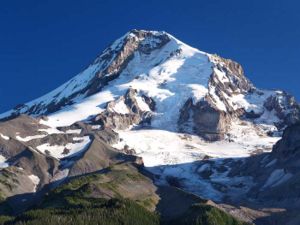Elk Cove Hike
From Oregon Hikers Field Guide
- Start point: Elk Cove Trailhead
- End point: Elk Cove
- Trail Log: Elk Cove Hike/Log
- Distance: 10.2 miles round-trip
- Elevation gain: 2200 feet
- High Point at Elk Cove: 5,460 feet
- Difficulty: Moderate
- Seasons: July - November
- Family Friendly: No
- Backpackable: Yes - connects to the Timberline Trail
- Crowded: Sometimes at Elk Cove on weekends
| Add-On Hikes: | Barrett Spur Add-on Hike | , Dollar Lake Add-on Hike |
Contents |
Description
This is a quiet alternative route to Elk Cove that avoids the crowds and bumpy access roads of the Vista Ridge and Cloud Cap approaches. The trail begins with a crossing of Pinnacle Creek, and then the first mile of the trail follows a tedious abandoned logging road past a single switchback. Soon, the trail branches off the road and begins to climb the wooded ridge that forms the west wall of Coe Canyon. The old route is steep at times as it steadily ascends the ridge. Approximately one mile from the abandoned road, the trail passes the top of an old clearcut and the obscure junction with an older alignment of the trail, to the left. From here, the route steepens again, climbing another mile over a crest, then into a saddle with a view of Mount Hood before arriving at the sweeping Coe Overlook, a rocky outcrop that provides views of Mount Hood and much of the surrounding terrain. Save some photos for your return trip, because the light is best in late afternoon.
From the overlook, the trail re-enters woods, and climbs for another mile to a crossing of Cove Creek. The water here is usually potable, though the creek does contain rock flour in high runoff periods. The route then climbs another 0.8 miles, winding through handsome subalpine forests, before emerging into wildflower displays at the fringes of Elk Cove. There are several campsites located along the trail just short of the junction with the Timberline Trail in the lush meadows of Elk Cove. Turn left for a few yards for the most sublime view of the mountain, rising above acres of wildflowers. The spectacular Coe Glacier dominates the north face of Mount Hood, and craggy Barrett Spur rises like a black wall above the meadows, framing the idyllic scene. Also be sure to walk to the far side of the cove, where a icy Cove Creek rambles through the meadows. Of the many wildflowers found here, none is as prolific as the western pasque flower, which blooms immediately after snowmelt, and thus before most hikers arrive. But the unusual seedheads appear by late July, and persist until frost -- the common name Old Man of the Mountain comes from the distinctive seedheads.
Backpackers should camp at one of numerous spots in the trees at the east or north ends of the cove along the Timberline and along the Elk Cove trail approach, and not in the fragile meadows.
There are a couple of logical add-ons to this hike. The hike to Dollar Lake is detailed here and the longer trek past Dollar Lake up Barrett Spur is listed here.
Maps
Trip Reports
- Search Trip Reports for Elk Cove
Related Discussions / Q&A
- Search Trail Q&A for Elk Cove





